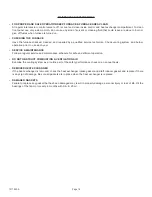
1017952-A
Page 4
SAFETY -
Continued
VENTING
1) Seal any unused openings in the venting system.
2) Inspect the venting system for proper size and horizontal
pitch, as required in the National Fuel Gas Code, ANSI
Z223.1/NFPA 54 or the Natural Gas and Propane Installation
Code, CSA B149.1 and these instructions. Determine that
there is no blockage or restriction, leakage, corrosion and
other deficiencies which could cause an unsafe condition.
3) As far as practical, close all building doors and windows
and all doors between the space in which the appliance(s)
connected to the venting system are located and other
spaces of the building.
4) Close fireplace dampers.
5) Turn on clothes dryers and any appliance not connected
to the venting system. Turn on any exhaust fans, such as
range hoods and bathroom exhausts, so they are operating
at maximum speed. Do not operate a summer exhaust fan.
6) Follow the lighting instructions. Place the appliance being
inspected into operation. Adjust the thermostat so appliance
is operating continuously.
7) Test for spillage from draft hood equipped appliances at
the draft hood relief opening after 5 minutes of main burner
operation. Use the flame of a match or candle.
8) If improper venting is observed during any of the above
tests, the venting system must be corrected in accordance
with the National Fuel Gas Code, ANSI Z223.1/NFPA 54
and/or Natural Gas and Propane Installation Code, CSA
B149.1.
9) After it has been determined that each appliance
connected to the venting system properly vents when tested
as outlined above, return doors, windows, exhaust fans,
fireplace dampers and any other gas-fired burning appliance
to their previous conditions of use.
!
WARNING:
CARBON MONOXIDE POISONING HAZARD
Failure to follow the steps outlined below for each appliance connected to the venting system being placed into
operation could result in carbon monoxide poisoning or death.
The following steps shall be followed for each appliance connected to the venting system being placed into operation, while
all other appliances connected to the venting system are not in operation:
USE AND AT LEAST ANNUALLY BY A QUALIFIED
SERVICE TECHNICIAN. More frequent cleaning
may be required due to excessive lint from
carpeting, bedding material, etc. It is imperative that
control compartments, burners, and circulating air
passageways of the appliance be kept clean.
16. Do not install in a closet, alcove, or small hallway
where the furnace could be isolated from the space to
be heated by closing a door.
17. Do not put anything around the furnace or vent cap that
will obstruct the flow of combustion and ventilation air.
18. The appliance, when installed, must be electrically
grounded in accordance with local codes or, in the
absence of local codes, with the latest edition of
National Electrical Code, ANSI/NFPA 70, or Canadian
Electrical Code, CSA C22.1, if an external electrical
source is utilized.
19. Never operate this furnace without the sight glass in
place or with the glass broken or missing.
20. If it is suspected that rising water may enter the furnace,
turn off the gas immediately.
21. Do not use this appliance if any part has been under
water. Immediately call a qualified service technician
to inspect the appliance and to replace any part of the
control system and any gas control which has been
under water.
22. It is necessary to replace damaged gaskets or sealing
material within the vent or air intake system. Failure to
do so may result in property damage, personal injury
or loss of life.
23. Any safety screen or guard removed for servicing
must be replaced prior to operating heater.
24. A gas appliance must not be connected to a chimney
flue serving a separate solid fuel burning appliance.
25. The appliance area must be kept clear and free from
combustilbe materials, gasoline and other flammable
vapors and liquids.
26. Any safety screen or guard removed for servicing
an appliance must be replaced prior to operating the
appliance.



































